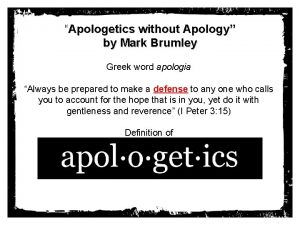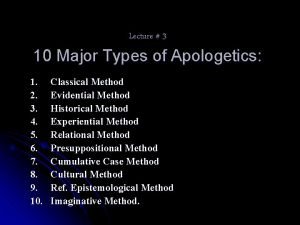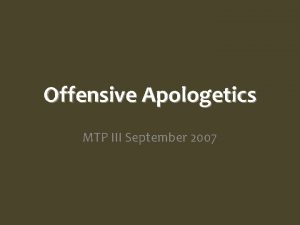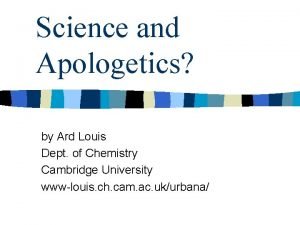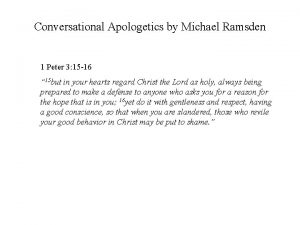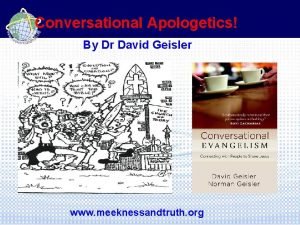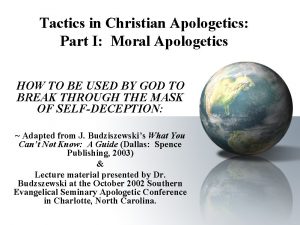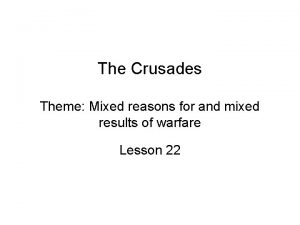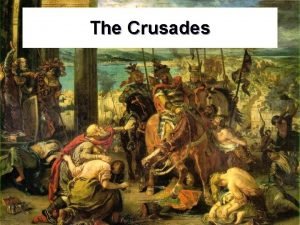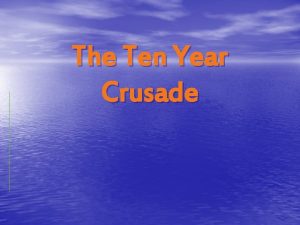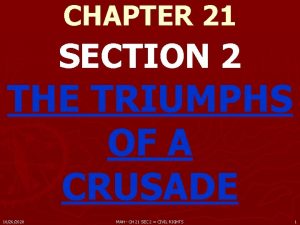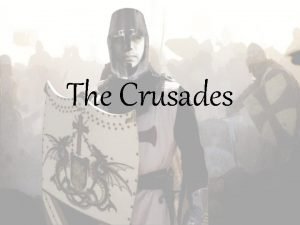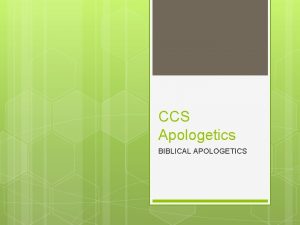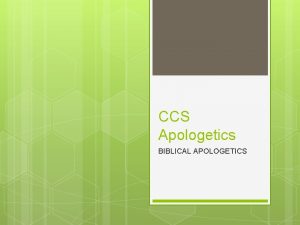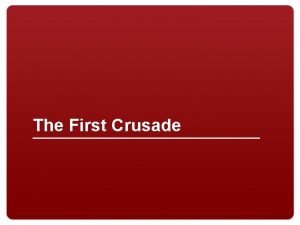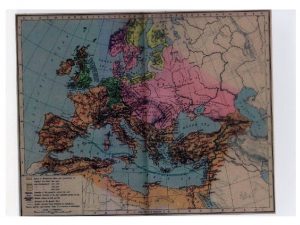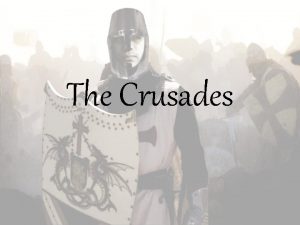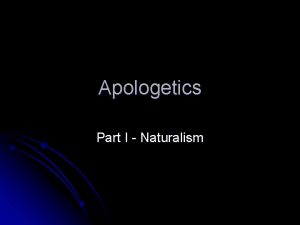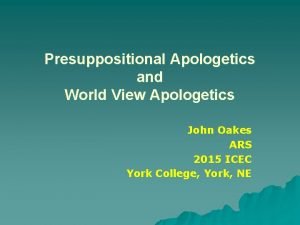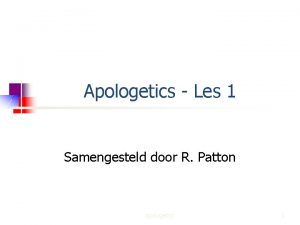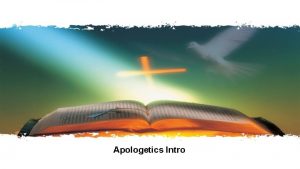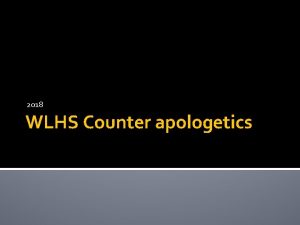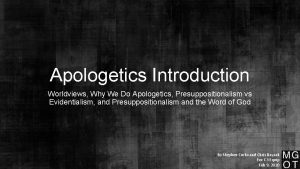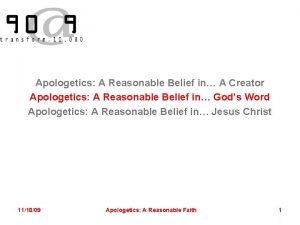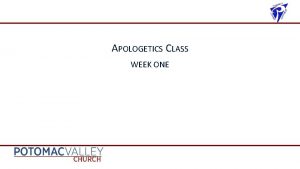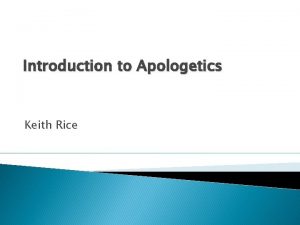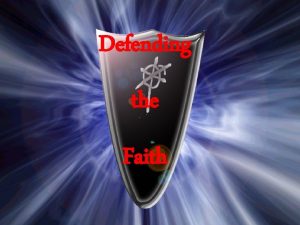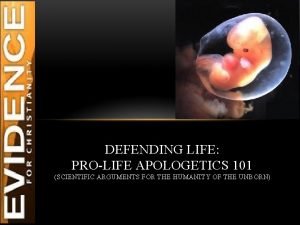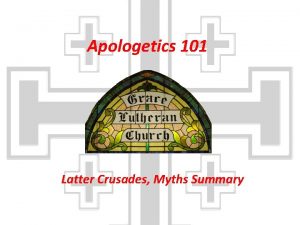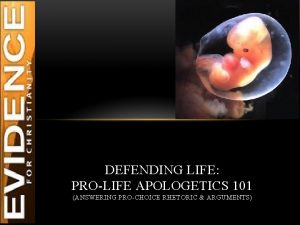Apologetics 101 The 1 st Crusade Council of























































- Slides: 55

Apologetics 101 The 1 st Crusade

Council of Clermont • Held on November 27 th, 1095. Pope Urban II preached the 1 st Crusade. • At least 5 different versions of the speech exist. The most famous is by Robert the Monk. • After recounting the atrocities of the Turks and arguing for the liberation of Jerusalem, those in attendance started shouting “Dieu li vult” or “Deus vult” (God wills it)!

Council of Clermont • Those in attendance started sewing cloth crosses on themselves, and the noble Raymond of Toulouse “took the cross” that day. • Because of this, it is likely this was somewhat orchestrated, as knights didn’t carry sewing kits! • Urban had been on the road for at least 4 months prior, talking with nobles, churchmen, businessmen etc…

Urban to Clermont

Council of Clermont

Recruitment • Urban launches an “army” of preachers all across central and northern Europe to preach the Crusade. • Urban himself went on a 9 month preaching tour. • In a sense, they were too successful. • Thousands upon Thousands “took the cross, ” including women, children, the elderly, and the knights and nobles the Crusade was intended for.




Motivations… • Modern chauvinists presume that the Crusade was based on greed, or other economic reasons (landless sons, colonies). • Some admit a religious element, but read the modernist idea of “intolerance” into the past. • Because the pre-Enlightenment, Christian West is hated by modernists, only pro. Muslim versions are allowed in popular culture.

For Land Loot? • Each knight had to raise 5 -6 times his annual income to go on crusade. • Some sold entire counties of land, and many bankrupted themselves. • Those of great means provided for those with lesser means, with the sharing of a “treasury wagon. ” • The non-armed children, women, and elderly needed to be cared for as well.

For Land Loot? • Many left in the latter parts of their lives (50’s), knowing they would probably never return. • Those that “chickened out” were so dishonored (including by their wives) that they would go back later to redeem their reputation. • Many had to purchase supplies such as war horses that equaled the yearly pay of a ship’s captain!

For Land Loot? • Contrary to some modernist historians, Europe was in an “uptick” economically, which allowed the Crusade to happen. • Many settled lawsuits and other disputes to their disadvantage. • It was also understood that recaptured lands would belong to Byzantium. • Most were Lords of entire estates and families, not “landless younger sons. ”

For Land Loot? “To impoverish one's family for the remote possibility of garnering wealth in Palestine would have been foolish in the extreme. The price was too great and the chances of return too slim. To understand why thousands of knights and their families made such profound sacrifices, one must remember that they were medieval, not modern people…”

For Land Loot? “The culture of nobility in the eleventh century was one of public displays of piety. Lords were known as much for their love of God as for their skill on the battlefield. Indeed, the two were seen as different sides of the same coin, neither possible without the other…By expending great wealth, they were storing up treasure where rust and moth could not corrupt…

For Land Loot? “By defending the church, they defended all that was good and true in their world. In short, most noblemen who joined crusade did so from a simple and sincere love of God. As is still true, people gladly march off to horrible wars if they believe that the cause for which they fight is noble, true, and greater than themselves. ” Madden, Concise History, 12 -13

“Crusading as an Act of Love” • The Crusaders honestly believed they were acting in fraternal Christian love by helping their brothers in the east, and those oppressed by Islam. • Most also truly believed that they were declaring their love of God by liberating the place in which he walked, proving their devotion. • However, how one should love enemies is not addressed.

“An Injured Lord” • Another image used in the Crusades is the feudal idea of honor due to a lord. • By the Holy Land being captured and the Church of the Holy Sepulcher desecrated, the Saving Lord of all was dishonored and disgraced. • If knights would rise up to defend the honor of their temporal lord, how much more so should they do so for their heavenly Lord?

A Family Affair • Most Crusaders were from groups of tightly connected families. • This aligns with most sociological data of those who join religious or political movements (Stark, 110). • Count William of Tete-Hardi of Burgandy: 3 sons go on Crusade, 4 th is a Pope 3 daughters married men who went 4 th daughter a mother of a 1 st Crusader Same Family sends 10 in the 2 nd Crusade.

A Family Affair • The families themselves were entwined, with Normans and Franks intermarrying and going on Crusade. • Families also had an extreme economic interest, with relatives sometimes supplying loans and arrangements being made through deeds, wills etc… • This leaves a large body of data for historians such as Jonathan Riley-smith to reconstruct.

Penance and Salvation? • A “warrior class” had developed during the middle ages, due to the sometimes volatile political situation. • By the 1000’s, things had quieted down, and some fought each other simply for sport, acting as friends afterwards! • The constant fighting troubled the Church, so much so they tried to pass laws forbidding fighting on certain days (the peace of God).

Penance and Salvation? • The lifestyle of some knights was very “worldly, ” as the Christian concept of chivalry was still in its infancy. • The Church would impose acts of penance, some severe, due to the great sins committed by some of the knights, who willingly submitted, knowing their guilt. • At first this concept was to demonstrate how sorry one was, but it began to be confused with salvation itself (indulgences).

Penance and Salvation? • Using the Roman argument of the power of the keys (Matthew 16), the Pope granted “remission of all sins. ” • Those who died on the way counted as martyrs. • Those who lived completed their penance. • The theologians of the church worked hard to find theological justification for this (war for penance) in the writings of the fathers and the Scriptures.

Penance and Salvation? “Considering how many are my sins and the love, clemency, and mercy of our Lord Jesus Christ, because when he was rich he became poor for our sake, I have determined to repay him in some measure for everything he has given me freely, although I am unworthy. And so I have decided to go Jerusalem, where God was seen as man and spoke with men, and to adore the place where his feet trod, ” – Stephen I of Neublans.

Other Theology • Viewed as a Defensive/Liberation war, via St. Augustine (Just War Theory). • The Crusade was an almost monastic undertaking in regards to status. • Many historians of the 1 st crusade saw the O. T as precedent, even viewing the Crusades as a fulfillment of prophecy! • The idea of “take up your cross and follow me” fulfilled literally in the Crusade.

Other Theology “A crusade army was a curious mix of rich and poor, saints and sinners, motivated by every kind of pious and selfish desire, yet it could not have come into being without the pious idealism that led men to risk all to liberate the lands of Christ. “ Madden, New Concise History.

Departure • Urban sets August 15 th as the departure date. • This was to maximize the harvest and to give the Byzantines and Hungarians time to prepare. • Armies lived “off the land, ” and pillaging was always a danger during this era. • Three different waves of Crusaders: People’s Crusade, German Crusade, Princes Crusade.


People’s Crusade Led by the charismatic Peter the Hermit. Mostly populated by the poorer classes. Religious enthusiasm at its extreme. Walter Sansavoir (Penniless) leads a small group of minor knights during this as well, against Urban’s advice. • After reaching Constantinople, Peter’s group crosses over into Turkey and is virtually annihilated, save for Peter himself. • •

Preaching of Peter the Hermit

People’s Crusade

German Crusade • Also an “early group”, inspired by the preaching of Peter. • Two leaders (Gottschalk and Volkmar), were there to organize stragglers from Peter. • These two led massacres of local Jewish populations, in spite of the church. • The bishops and Urban tried to stop it when possible. • The two groups wiped out by Hungarian knights; viewed as just punishment.

German Crusade • A minor noble named Emicho Leisingen from the Rhineland area of Germany also organized a small army. • He led a systematic attack on Jews throughout Germany (Spier, Worms, etc…). • The local bishops take Jews into their cathedrals to protect them. • Emicho then attacks towns without church leaders. • His army is wiped out by Hungarians.

Princes’ Crusade • The actual Crusade Urban and the church intended. • Led by the sons of Kings and great noble houses. • Carefully organized and led by military veterans, some of whom had fought the Turks as mercenaries for Byzantium. • 5 main contingents, each taking a different route to ease the burden on locals.

Princes’ Crusade • Godfrey of Bouillon • Hugh of Vermandois • Robert of Normandy • Bohemond of Taranto • Raymond of Toulouse

Princes’ Crusade

Princes’ Crusade Other Important Figures: Robert II of Flanders Baldwin of Boulogne (first King of Jerusalem) Adhemar of Le Puy (Spiritual Leader) Tancred (nephew of Bohemond) Stephen of Blois Eustace III of Boulogne (almost King) Fulcher of Chartes (eye-witness historian) Raymond of Aguilers (historian as well)


Routes of the Crusaders

In Constantinople • Each group arrives at Constantinople separately. • The Emperor uses this to his advantage, causing all to swear some sort of oath to him. • The Crusaders are in awe of the greatest city of the Christian World. • They are all ferried across the Bosporus, where they join up and begin to march towards Jerusalem.

Siege of Nicea • First major battle is the siege of Nicea (site of two ecumenical councils). • Thinking it was another People’s Crusade, the Turkish ruler left his family and treasury while on campaign out east. • After trying to return, the Turks suffer a major defeat with heavy losses. • The Byzantines then roll ships on logs overland to blockade the lake.

Siege of Nicea • Emperor Alexios secretly negotiates a surrender before a general assault. • Nicea becomes Byzantine virtually overnight, and the Crusaders are not allowed to reap the rewards. • This creates hostility, although Alexios rewards them greatly and reinforces his contingent.

Siege of Nicea

Baldwin Received in Edessa

Antioch (1097 -1098) • After Nicea, the Crusaders march to Antioch. • One of the great cities of the ancient world, with impressive fortifications. • The Crusaders are unable to completely surround it, allowing partial re-supplying. • A Turkish army approaching, Bohemond bribes a tower guard, after 8 months • Bohemond is successful, and the Crusaders take the city.

Antioch (1097 -1098) • Almost immediately, the Crusaders become the besieged. • When all hope seems lost, the monk Peter Bartholomew has a vision of the Holy Lance. • In spite of skepticism, a rusty end is dug up, and the troops feel invincible. • Because Raymond is ill, Bohemond leads a charge out of the city, and wins a smashing victory.

Antioch (1097 -1098) • Many of the eye-witnesses and the chroniclers say that an army from heaven (saints, angels ect…) were fighting alongside. • Bohemond becomes the prince of Antioch after much squabbling, because Alexios is viewed as a traitor to the cause. • After a long and hard delay where disease broke out, the Crusaders march towards Jerusalem.

Siege of Antioch (Dore)


Jerusalem (1099) • Around 15 -20, 000 left of the original 4050, 000 actual military men. • Jerusalem controlled by Fatimid Egypt, rather than the Turks. • The troops are resupplied along the way by Italian ships (Genoa, Pisa etc…) • After reaching Jerusalem, all seems lost until the Italians bring lumber to build siege engines.

Jerusalem (1099) • Priest Peter Desiderius has a vision that they are to pray, repent, and march around the walls barefoot, like the story of Jericho. • This act brings the bickering troops together. • On July 15 th, 1099, Jerusalem is in Crusader hands. • To describe the onslaught, some Crusade historians use apocalyptic imagery, leading to the “ankles in blood” quote.

The Siege of Jerusalem (1099)



Personal Info Email: aarondhayes@gmail. com Web/blog: hayesworldview. wordpress. com Powerpoint/notes will be available on website
 Apologetics
Apologetics Types of apologetics
Types of apologetics Offensive apologetics
Offensive apologetics Apologetics
Apologetics Conversational apologetics
Conversational apologetics Conversational apologetics
Conversational apologetics Moral apologetics
Moral apologetics Fourth crusade
Fourth crusade Crusade themes
Crusade themes Crusades used in a sentence
Crusades used in a sentence It is the peaceful crusade or campaign for reforms.
It is the peaceful crusade or campaign for reforms. Alicia cardell
Alicia cardell Chapter 29 section 2 the triumphs of a crusade
Chapter 29 section 2 the triumphs of a crusade What is a crusade
What is a crusade Vẽ hình chiếu vuông góc của vật thể sau
Vẽ hình chiếu vuông góc của vật thể sau Cong thức tính động năng
Cong thức tính động năng Thế nào là mạng điện lắp đặt kiểu nổi
Thế nào là mạng điện lắp đặt kiểu nổi Tỉ lệ cơ thể trẻ em
Tỉ lệ cơ thể trẻ em Lời thề hippocrates
Lời thề hippocrates Vẽ hình chiếu đứng bằng cạnh của vật thể
Vẽ hình chiếu đứng bằng cạnh của vật thể độ dài liên kết
độ dài liên kết Quá trình desamine hóa có thể tạo ra
Quá trình desamine hóa có thể tạo ra Các môn thể thao bắt đầu bằng từ đua
Các môn thể thao bắt đầu bằng từ đua Khi nào hổ mẹ dạy hổ con săn mồi
Khi nào hổ mẹ dạy hổ con săn mồi điện thế nghỉ
điện thế nghỉ Dot
Dot Biện pháp chống mỏi cơ
Biện pháp chống mỏi cơ Trời xanh đây là của chúng ta thể thơ
Trời xanh đây là của chúng ta thể thơ Voi kéo gỗ như thế nào
Voi kéo gỗ như thế nào Thiếu nhi thế giới liên hoan
Thiếu nhi thế giới liên hoan Phối cảnh
Phối cảnh Các châu lục và đại dương trên thế giới
Các châu lục và đại dương trên thế giới Một số thể thơ truyền thống
Một số thể thơ truyền thống Thế nào là hệ số cao nhất
Thế nào là hệ số cao nhất Hệ hô hấp
Hệ hô hấp Tư thế ngồi viết
Tư thế ngồi viết Số nguyên tố là
Số nguyên tố là Hát kết hợp bộ gõ cơ thể
Hát kết hợp bộ gõ cơ thể đặc điểm cơ thể của người tối cổ
đặc điểm cơ thể của người tối cổ Mật thư tọa độ 5x5
Mật thư tọa độ 5x5 Chụp phim tư thế worms-breton
Chụp phim tư thế worms-breton ưu thế lai là gì
ưu thế lai là gì Thẻ vin
Thẻ vin Cái miệng nó xinh thế
Cái miệng nó xinh thế Các châu lục và đại dương trên thế giới
Các châu lục và đại dương trên thế giới Bổ thể
Bổ thể Từ ngữ thể hiện lòng nhân hậu
Từ ngữ thể hiện lòng nhân hậu Diễn thế sinh thái là
Diễn thế sinh thái là Tư thế ngồi viết
Tư thế ngồi viết Thế nào là giọng cùng tên
Thế nào là giọng cùng tên Làm thế nào để 102-1=99
Làm thế nào để 102-1=99 Thể thơ truyền thống
Thể thơ truyền thống Bài hát chúa yêu trần thế alleluia
Bài hát chúa yêu trần thế alleluia Hổ sinh sản vào mùa nào
Hổ sinh sản vào mùa nào đại từ thay thế
đại từ thay thế
